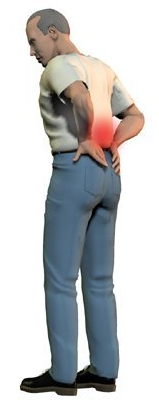Greetings
In the past month we have added 30 new FAQ and Research articles to our patient education resource.
We have also added the following patient guides:
- Osteoarthritis of the Elbow
- Elbow Dislocation
- Sacroiliac Joint Dysfunction
- Transcutaneous Electrical Nerve Stimulation (TENS)
In this newsletter we are discussing back Pain.
The Role of physiotherapy for Back Pain
 Back pain can slow you down and even stop you in your tracks. If you’ve suffered from back pain – whether from an acute injury or chronic strain– you’ve probably tried many approaches and gotten a lot of different advice on how to make it better.
Back pain can slow you down and even stop you in your tracks. If you’ve suffered from back pain – whether from an acute injury or chronic strain– you’ve probably tried many approaches and gotten a lot of different advice on how to make it better.
Some people only consider physiotherapy after they’ve gone through a laundry list of home remedies, but physiotherapy can make a difference regardless of what stage of back pain you are in right now. Even if the source of your chronic pain hasn’t been identified, physiotherapy can help you get back to doing what you love and keep you from missing work.
But shouldn’t I just be resting until I feel better?
Although this depends on the exact nature and severity of your pain, most physiotherapists – anywhere in the world – will try to avoid putting you on bed rest or otherwise immobilizing you for longer than a few days.
Bed rest may be helpful to get through the first day or two after an injury, but a review of multiple studies suggests there is no difference whatsoever in pain or function between staying active and staying in bed, even just one week after the pain starts.
When it comes to pain that isn’t related to a specific injury, not only is long-term bed rest impractical, it also isn’t helpful: for sciatica patients, the benefits of bed rest are negligible after two weeks, no better than simply going about your business and being mindful about your back.
So if simply resting isn’t going to make it better, and if your acute back pain is keeping you from what you want to do, you’ll need a more active approach to treat your pain. Physiotherapy is just such an active approach, and it is appropriate for both acute and chronic pain.
Visit the low back patient education zone on our website to learn more.
What will I be doing?
At In Balance Physiotherapy we will probably combine multiple approaches in treating you, because everyone is different and requires different care. Most likely, the care you receive will involve or more of these activities:
● Stretching and strengthening exercises
● Soft tissue massage and manual therapy
● Posture correction
● Traction
● Applying heat or cold to affected areas
● Learning about what kinds of everyday activities will help or hurt
Our physiotherapists will assess your particular situation and develop a personalized plan for you.
What if I don’t like doing the exercises?
Yo ur active participation is a very important part of getting better and staying in the game of life. Your physiotherapist is your coach and will pick exercises for you designed to improve your body’s function, and some may be uncomfortable when you first do them.
ur active participation is a very important part of getting better and staying in the game of life. Your physiotherapist is your coach and will pick exercises for you designed to improve your body’s function, and some may be uncomfortable when you first do them.
This may make you want to stop your treatment, but there is good evidence that working with this pain – under the direction of your physiotherapist – will get you through to a future with less pain. This is why it’s key to stick to your routine and see your treatment through to the end, keeping your physiotherapist informed of how things feel as you progress so that the exercises can be adapted if need be.
Everyone has their own opinions on how to manage their own health, and that’s a good thing. There has even been a study showing that physiotherapy is just as effective a treatment for back pain whether or not you agree with your physiotherapist all of the time.
In Balance Physiotherapy will work with you to help you get back to what you want to be doing.
How can I get started?
If you’re ready to consider adding physiotherapy to your fight against back pain, come in and speak with one of the trained physiotherapists at In Balance Physiotherapy. We would love to help you get back to your regular life, and we are ready to listen and work with you on a personalized approach.
References
- Kool JP, Oesch PR, Bachmann S, et al. Increasing days at work using function-centered rehabilitation in nonacute nonspecific low back pain: a randomized controlled trial. Arch Phys Med Rehabil 2005; 86:857–864
- Bhargava A, Gelb D, Ludwig S, DePalma MJ. Physical therapy for low back pain. Current Opinion in Orthopaedics 2006; 17(3):199-207
- Hagen KB, Hilde G, Jamtvedt G, Winnem MF. The Cochrane review of bed rest for acute low back pain and sciatica. Spine 2000; 25:2932–2939
- Vroomen PC, de Krom MC, Wilmink JT, et al. Lack of effectiveness of bed rest for sciatica. N Engl J Med 1999; 340:418–423
- Poitras S, Blais R, Swaine B, Rossignol M. Management of work-related low back pain: a population-based survey of physical therapists. Phys Ther 2005; 85:1168–1181
- Azoulay L, Ehrmann-Feldman D, Truchon M, Rossignol M. Effects of patient–clinician disagreement in occupational low back pain: a pilot study. Disabil Rehabil 2005; 27:817–823